How Time Slot Management Could Help Resolve Port Congestion
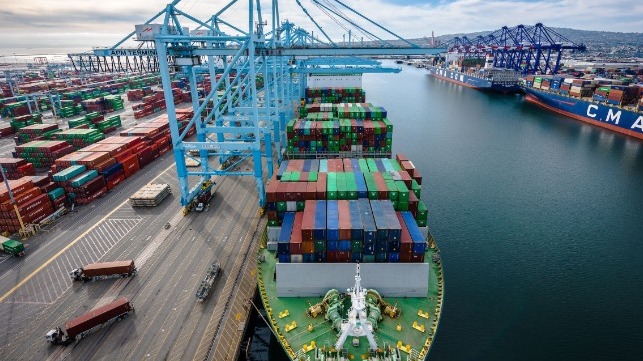
[By Mikael Lind, Wolfgang Lehmacher, Jan Hoffmann, Lars Jensen, Theo Notteboom, Torbjörn Rydbergh, Peter Sand, Sandra Haraldson, Rachael White, Hanane Becha and Patrik Berglund]
Abstract
Disruption and congestion are occurring across the global maritime supply chains. Since the summer of 2020 rising capacity shortages in terms of boxes, ships and port infrastructure have driven maritime and port actors to find alternative options and to optimize infrastructure usage. Much of the contemporary debate on how to resolve the situation is centred around just-in-time vessel arrival at ports, but that only addresses part of the problem. The many operators and clients of maritime supply chains need to overcome these times of continuous shocks, disruptions and high uncertainty. This works best with a high level of visibility. In this contribution, we propose the use of time slots and data sharing that will empower the different parties to make more informed and flexible plans to overcome the disruptions and congestion in the supply chain system and improve supply chain visibility. This contribution is a call for an expansion of the JIT arrival approach to incorporate a slot management concept that includes a dynamic view and management of JIT arrivals and departures to better manage uncertainties.
Introduction
Port congestion, poor schedule integrity and container imbalances are making headlines. The recent Ever Given incident in the Suez Canal[1] brought shipping and the delayed arrival of cargo into the news. But the problems go much further. Many think that maritime supply chains are disjointed and that ports are insufficiently synchronized with ship journeys and multi-modal transport capacity in the hinterland. Record high freight rates reflect the current situation in the maritime sector. With the supply chain under pressure, the resulting imbalance between demand and supply has led to a surge in the prices to move containers (see figure 1).
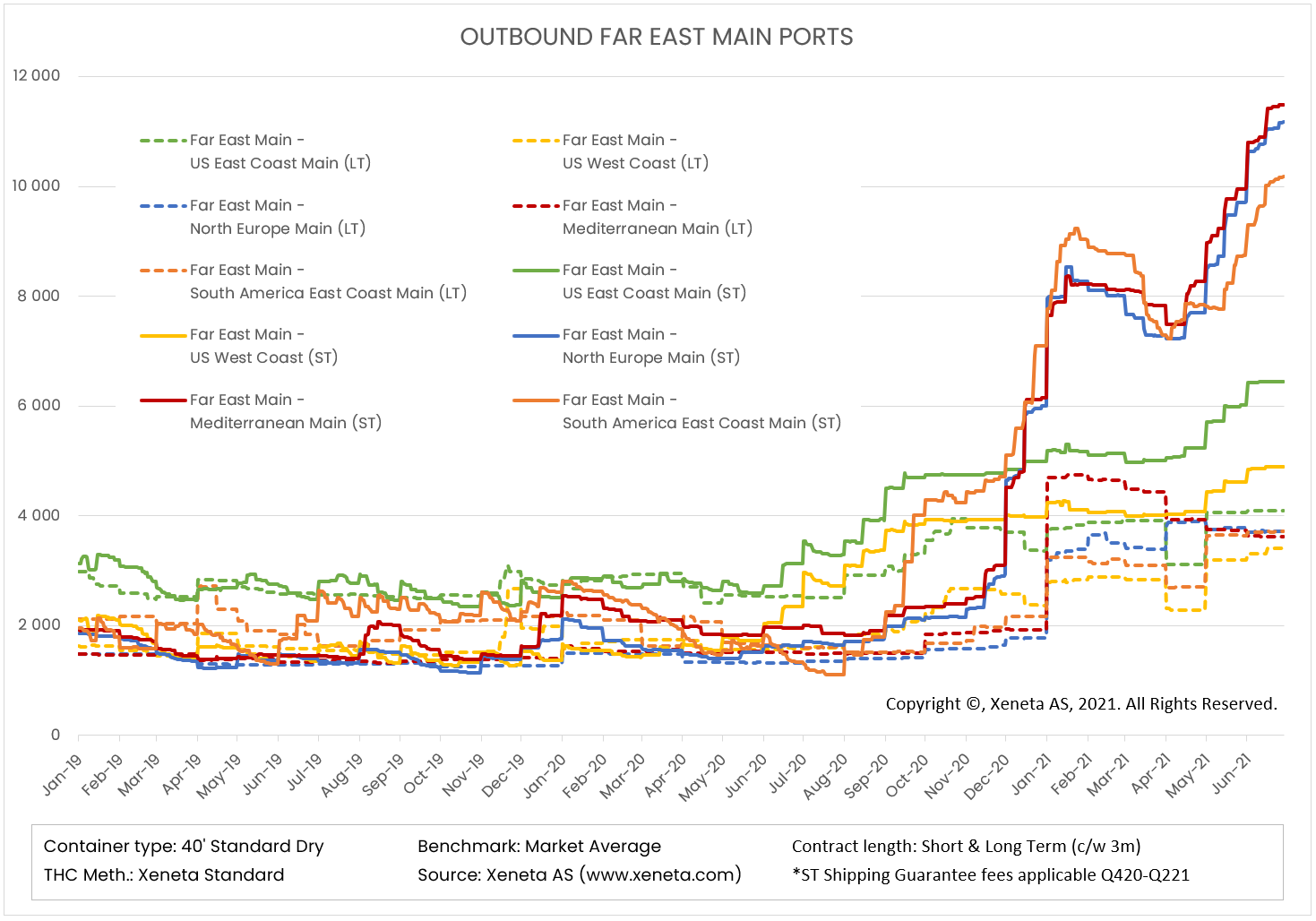
Figure 1: Development of long- and short-term freight rates for a 40’ container on selected trades outbound from Far East main ports during 1st of January 2019 to 28th of June 2021
Over the last months there has been a lot of attention paid to the ports along the United States of America (U.S.) West Coast - Long Beach and Los Angeles in the San Pedro Bay area and Oakland near San Francisco, which together handle about 40 percent of U.S. imports from Asia. Recently, delays at these ports have reached extraordinary levels, with some of the largest ships waiting nearly three weeks to get to berth (see graphs in figure 2) with obvious impacts on both import and export cargo flows.
The congestion has been blamed on shortcomings in infrastructural and resource capabilities.[2] But the situation is more complex than that, as the reasons for constrained port infrastructure are many. For example, in the case of Oakland, it is understood that a ship caught fire and was occupying a berth much longer than planned. Manning availability at the ports has also been questioned.[3]
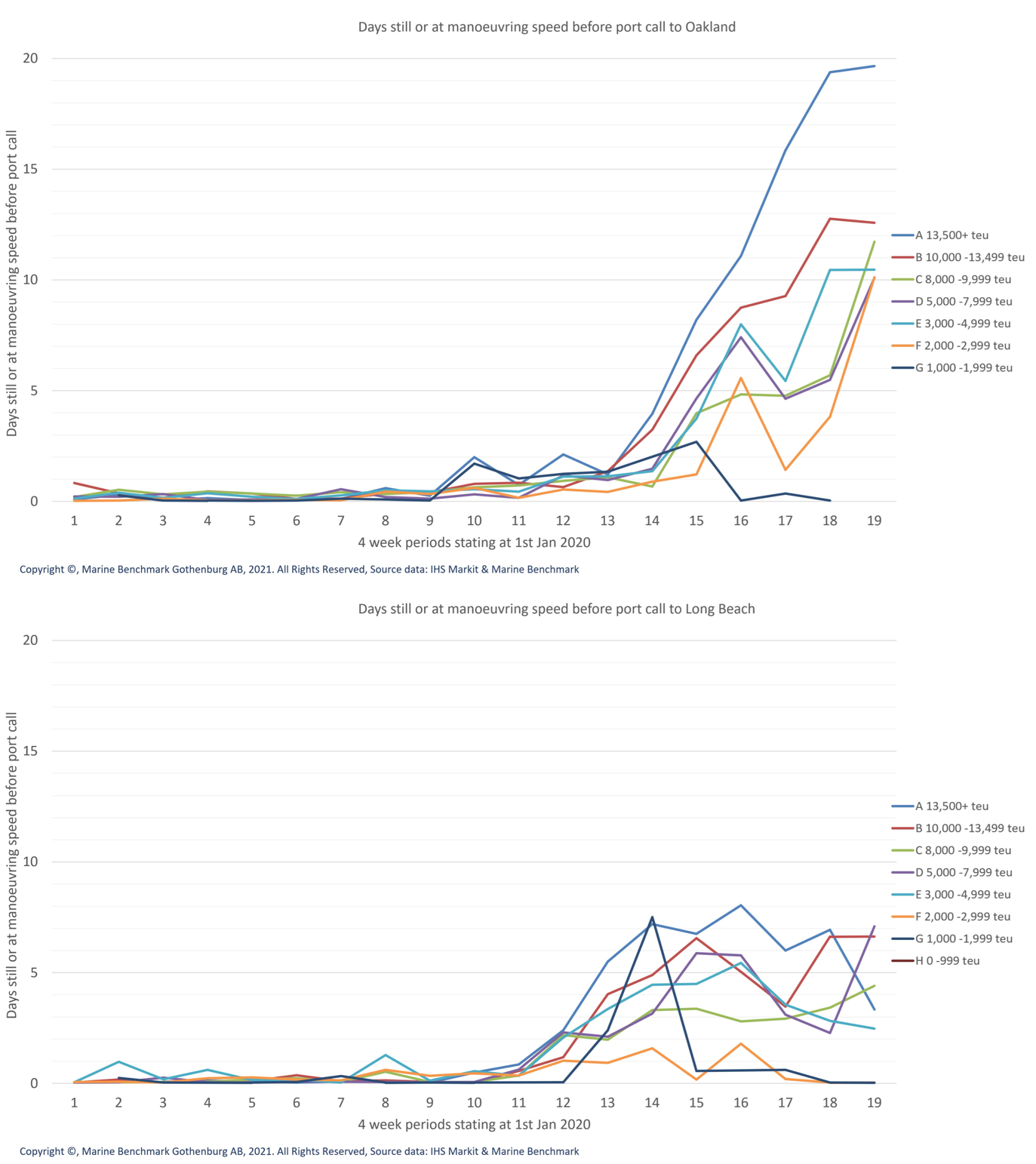 Figure 2: Average waiting times (days) in 4 weeks periods for 451 container ships that made 2400 port calls to Port of Oakland (1222 calls) and Port of Long Beach (1178 calls) during the period 1st of January 2020 to 13th of June 2021.[4]
Figure 2: Average waiting times (days) in 4 weeks periods for 451 container ships that made 2400 port calls to Port of Oakland (1222 calls) and Port of Long Beach (1178 calls) during the period 1st of January 2020 to 13th of June 2021.[4]
The main concern for supply chains is to reach higher levels of certainty throughout the chain while also capturing possibilities to reduce costs and emissions. Shipping companies as well as the clients of the maritime supply chains try to develop mitigating strategies to reduce vessel waiting times and uncertainty about when a vessel will be served by the port, such as by getting to the port area as quickly as possible or by overbooking facilities. This is wasteful, costly and inefficient.
The fundamental underlying cause for the current delays and high freight rates is a shortage of capacity, including ships, containers, trailers, and vehicles needed for the intermodal transport operation.
The logistics industry has basically two options to get back to normal. It could increase the pool of equipment to have spare capacity at its disposal so that when demand surges or supply is disrupted, the extra ships, containers, vehicles, and trailers can provide the additionally required supply. This is wasteful, costly and inherently inefficient. Alternatively, it could introduce ways that allow the existing capacity to handle a larger volume of cargo. In this paper, we focus on the latter option.
A continuous struggle
Globally, congestion arising in capacity-constrained areas will continue to occur. The disruption in the container port system in southern China, like in the U.S. West Coast ports, is another recent example. Such disruptions often impact each other. Congestion tends to move from location to location along capacity-constrained supply chains. For example, congestion at U.S. West Coast ports may be temporarily relieved with less ships traveling from Asia to the U.S. But, as the constraints ease in Asia, congestion on the U.S. West Coast will probably re-emerge.

Figure 3: Congestions moves along the maritime supply chain
How are ships behaving at congested ports?
It is commonly assumed that ships drop anchor outside a port and sit and wait when confronted with port congestion. However, a significant number of ships waiting for a berth opt to drift or loiter outside the port instead.[5]
For example, the port rotation from Long Beach to Oakland with a usual travelling distance of around 385 Nautical Miles peaked at an average travelling distance of more than 1600 Nautical Miles for the larger container vessels. For rotations from Los Angeles / Long Beach to the congested zone of Oakland / San Francisco, port congestion increased the usual steaming distance by a factor of at least 4.
The same trend of expanding travelling distance can also be observed in figure 4 for the 145 ships that conducted 322 port calls in Oakland over a 15-month period originating from Long Beach. For ships travelling in the opposite direction (Oakland to Long Beach) in the same 15-month period the distance travelled ranged from 389 Nautical Miles to 425 nautical miles, inferring that Long Beach was less congested resulting in reduced waiting times and therefore less need for anchoring outside the port and fewer ships loitering and adding unnecessary miles to the distance travelled between the two ports.
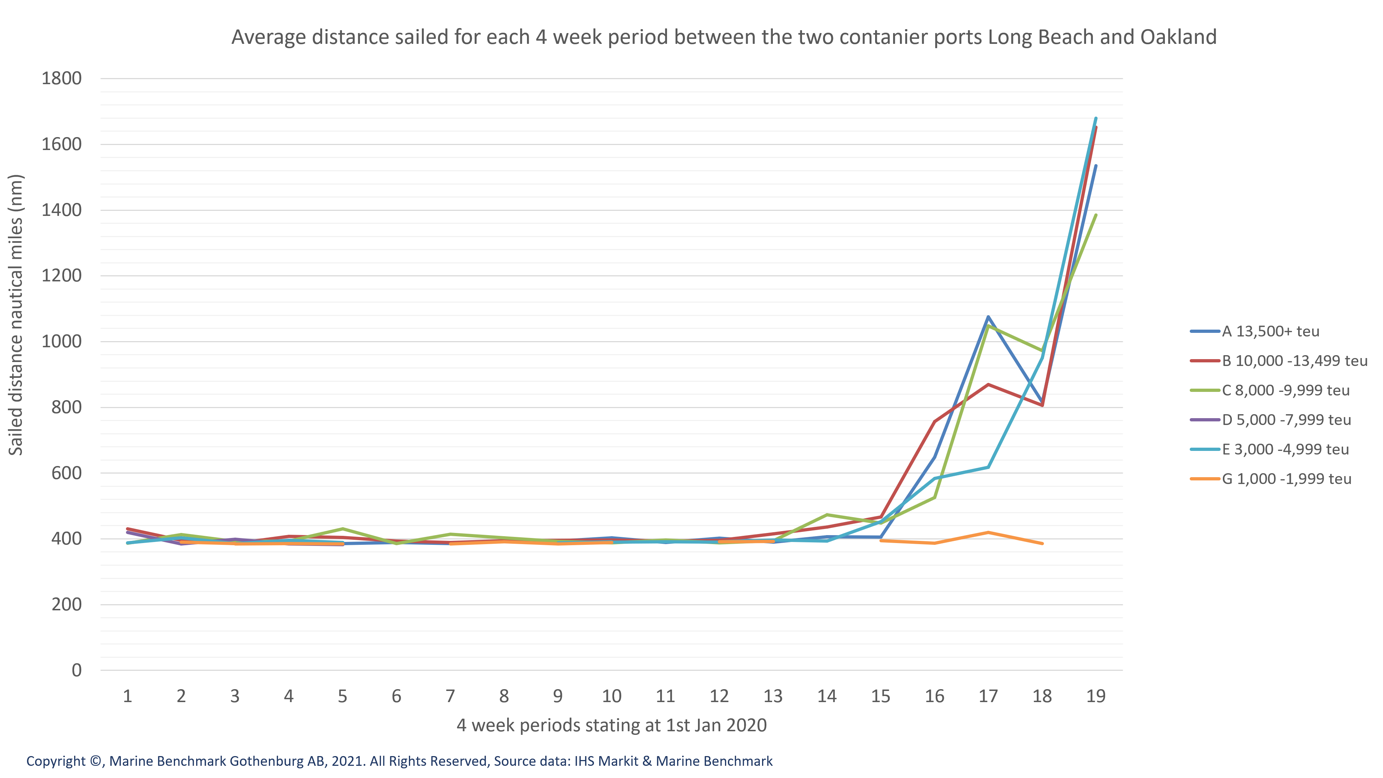 Figure 4: Actual distance travelled between Long Beach and Oakland (for 145 ships on 322 voyages from Long Beach to Oakland between 1st January 2020 and 13 June 2021)
Figure 4: Actual distance travelled between Long Beach and Oakland (for 145 ships on 322 voyages from Long Beach to Oakland between 1st January 2020 and 13 June 2021)
Long Beach and Oakland are not the only ports facing such a situation. Figure 5 shows global figures for container ships waiting outside ports globally. Figures for China and the U.S. West Coast are also provided.
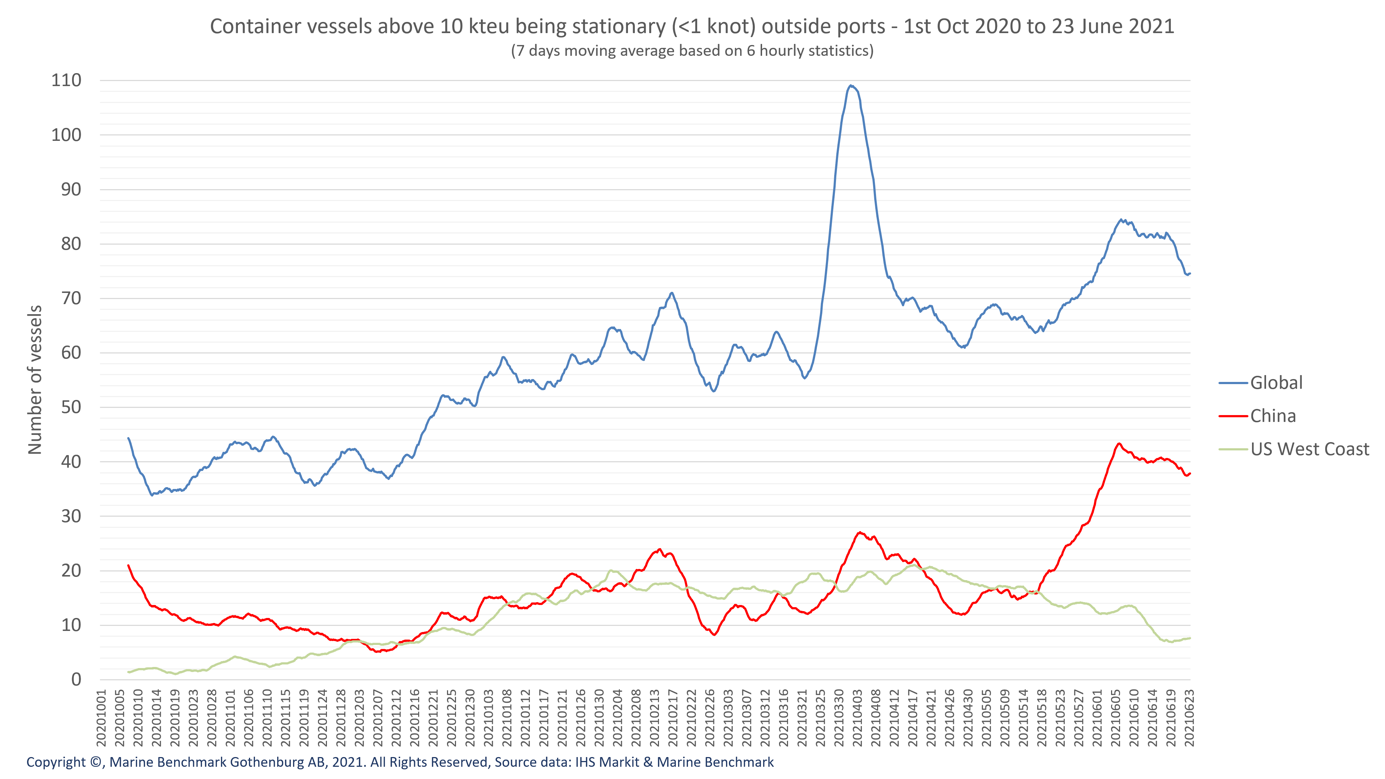 Figure 5: Number of container ships being stationary outside ports globally and outside China and U.S. West Coast ports between 1 October 2020 and 23 June 2021
Figure 5: Number of container ships being stationary outside ports globally and outside China and U.S. West Coast ports between 1 October 2020 and 23 June 2021
Congestion is further confirmed for ports around the world in the following two diagrams (figure 6) that show the movement status of container ships making visits to major ports in Asia and along the U.S. West Coast.
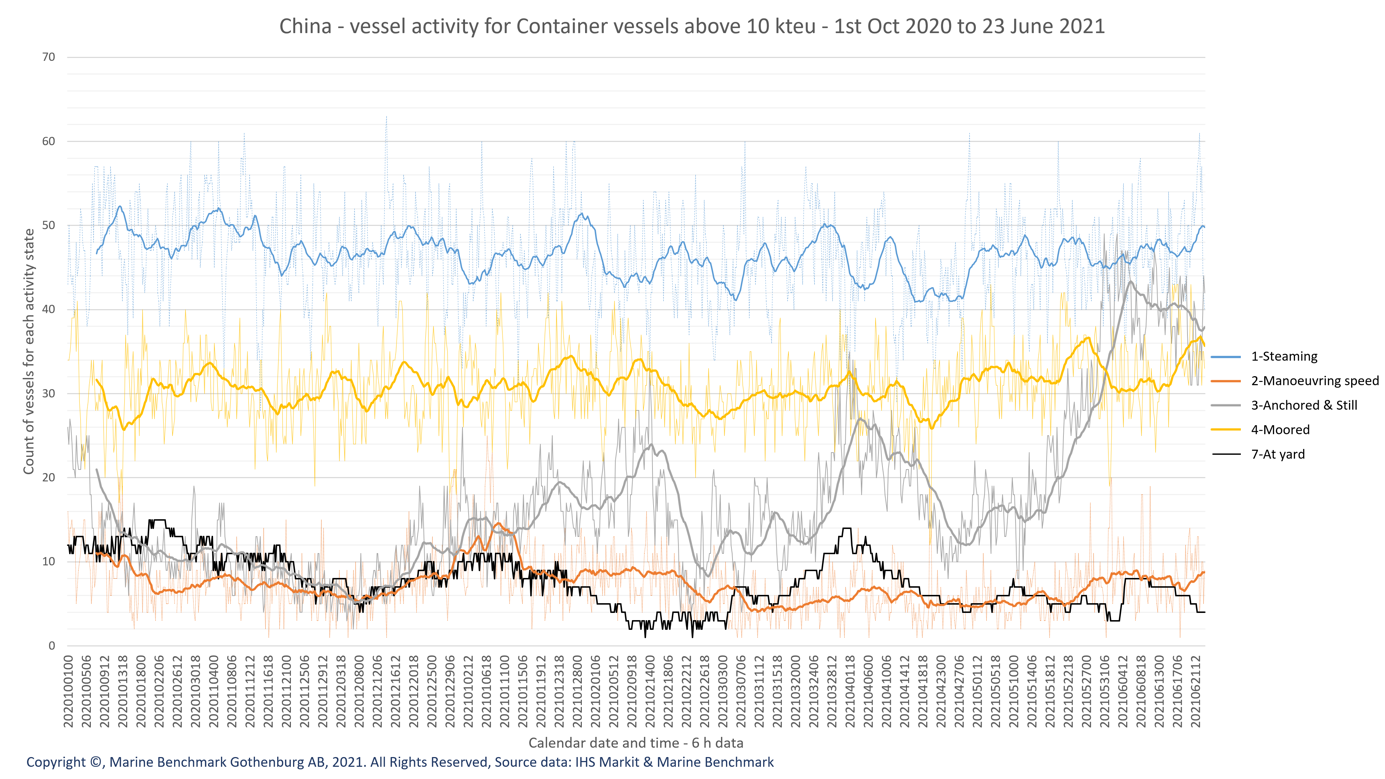
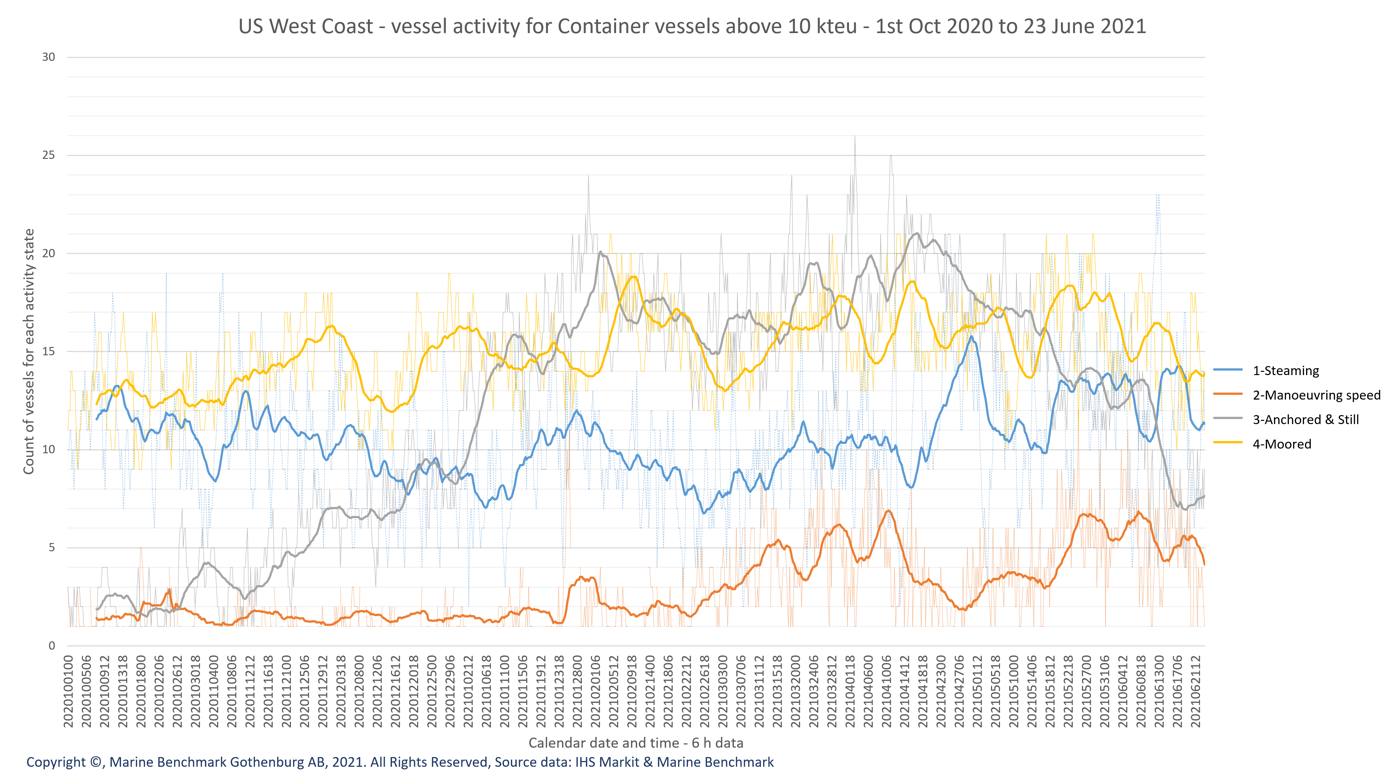 Figure 6: Developments in China and in the US west coast on the number of vessels “steaming” (speed > 6 knots), “manoevring” (speed between 1 and 6 knots), “anchored & still” (speed <1 knot and outside port area), “moored” (speed <1 knot and within port area), “at yard” (speed <1 knot within yard area).
Figure 6: Developments in China and in the US west coast on the number of vessels “steaming” (speed > 6 knots), “manoevring” (speed between 1 and 6 knots), “anchored & still” (speed <1 knot and outside port area), “moored” (speed <1 knot and within port area), “at yard” (speed <1 knot within yard area).
How to achieve a higher degree of predictability for arrival and departure times
The maritime sector is putting increasing focus on seeking opportunities from digitalization that can enhance coordination and synchronization in the self-organized ecosystem of the maritime supply chain network. One promising initiative is the introduction of virtual vessel arrival and standardized data exchange for just-in-time (JIT) arrival promoted by numerous stakeholders associated with the maritime industry.[6] The proposed JIT arrival approach makes the case that a port provides a recommended time of arrival (as outlined in figure 6). This approach will also help, in part, to address what is needed for the reduction of greenhouse gas (GHG) emissions in the recent International Maritime Organization (IMO) Global Industry Alliance (GIA) guide on JIT.[7] However, JIT limits itself to a port to ship interface and could result in a one-sided port view which may cause concern for shipping lines particularly during times of port congestion.[8]
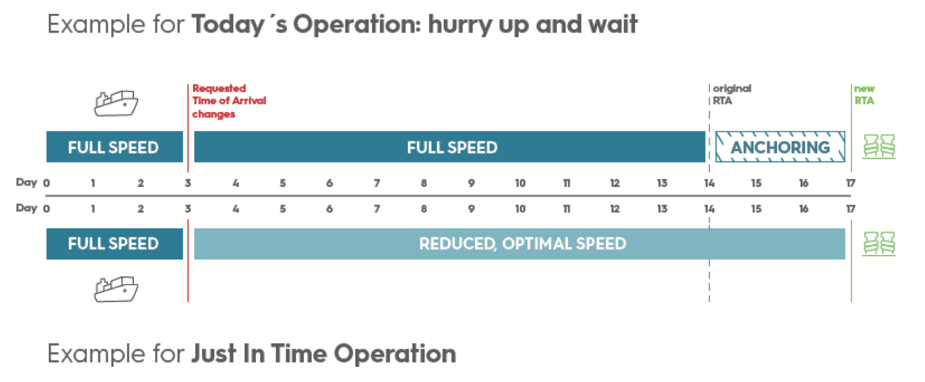
Figure 7: Today’s operations vs. JIT arrival (IMO (2020) Just In Time Arrival Guide - Barriers and Potential Solutions)[9]
One way of avoiding this would be the introduction of slot times, that could be used in an elastic way,[10] and under conditions that all the involved parties collectively govern. When implemented in a transparent fashion, this would also give beneficial cargo owners increased visibility and greater confidence, which would lead to less uncertainties, a reduced requirement for contingency buffering and less money wasted.
Accordingly, we propose an expansion of the JIT arrival approach to incorporate a slot management concept that includes a dynamic view and management of JIT arrivals and departures. This would be informed by shared data providing up-to-date progress and planning information on queues and waiting times associated with ports as maritime chokepoints. It would allow all participants to operate more effectively in the extensive maritime chain.
What are other industries doing with time slots?
Using slot times as the denominator for the engaged parties is what constitutes the appointment economy, allowing both the customer and the supplier to coordinate on a common basis and to inform the other party if either of the parties are experiencing challenges in meeting the agreed / aimed slot times.[11] This logic can be seen in many of the human practices that require collaboration between multiple parties, for example for a doctor’s appointment, repairing a car, or producing a particular product, where resources and infrastructure that are co-shared by many clients are planned to be available for the particular client.
Although not directly transferrable, the analysis of practices in other industries may help to inspire our maritime time slot thinking and shape solutions to deal with disruption and congestion in the maritime industry. The following examples show how slot times work in different situations.
In the European aviation system, for most commercial flights, an airplane cannot depart from the airport of origin without having obtained a confirmed slot time at the airport of destination. The slot times, delimited by an arrival and a departure time, enable the actors operating at the destination airport to be well-coordinated and synchronize their activities. The A-(Airport)CDM (Collaborative Decision Making) concept has an important role in this coordination. Because airports suffering from constrained infrastructure and congestion can limit the number of slots for flight arrivals, the aviation sector self-governs such situations before take-off and avoids unnecessary fuel and operating expenses and carbon emissions, and mid-air diversions or excessive waiting in holding patterns before landing. The outcome of the A-CDM process would usually be changing to a different time slot, and in extreme cases a cancellation an choosing an alternative destination airport.
Express delivery companies increasingly consult receivers of goods about their preferred time of delivery to avoid unnecessary delivery attempts. Large manufacturing plants and retail outlets often specify a delivery time window - in order to avoid congestion and ensure that the goods can be offloaded and stored efficiently. For home deliveries, delivery preferences go beyond only fixing the preferred delivery date and time but also can include a choice of alternative delivery points, like pick-up points or delivery to neighbors.
However, it must be acknowledged that all the examples above relate to relatively short journey times, unlike in the maritime sector where the time of arrival may be several weeks or even months after the departure. The longest air transit will seldom exceed 48 hours, including intermediate stopovers; even an intercontinental road transit delivery can be measured in days rather than weeks. Meanwhile, a trans-global ship journey could last weeks and involve a number of intermediate port visits. This means that, unlike an air transit or a local land-based delivery, there are many more opportunities for conditions to change en route (weather, breakdown, delays in intermediate ports, and so on) resulting in more unpredictable and sometime cumulative delays or disruptions after the journey has commenced. This difference means that any time slot mechanism adopted for port calls must be much more dynamic and capable of adjustment for such ongoing changes. This can be achieved through improved data sharing between all the involved actors and by adopting the principles of Port Collaborative Decision Making (PortCDM) or Port Call Optimization.[12]
Slot management can ease the pressure
Adopting the concept of slot management can ease the current pressures on ports, carriers and shippers caused by congestion and the consequent unpredictability and increased expenditure. As is the case for other practices grounded in the appointment economy, the slot time is the unit of analysis,[13] allowing us to move beyond coordination based on physical arrival and the principles of first-come, first-served.[14] A slot time provides each involved actor, on a fair and equal basis, with the opportunity to plan ahead, regularly monitor progress and coordinate their activities towards achieving the common goal of a satisfactory, predictable and timely delivery. At the same time supply chain visibility to all those that need to know is improved, meaning less surprises and the need to make alternative plans at short or no notice.
We see opportunities to expand the model of JIT shipping to cover the range of typical scenarios (see figure 8 below), by delimiting arrival and departure slots. In this context, predictions of departure are important as these provide an understanding of when the infrastructure being used for one ship can be made available for another.
 Figure 8: Alternatives for just-in-time shipping conducted with optimal energy efficiency
Figure 8: Alternatives for just-in-time shipping conducted with optimal energy efficiency
Scenario A is when the time of departure from the previous port enables just-in-time arrival to the next port allowing for optimal steaming speed to destination.
Scenario B is when there are delays in departure from the previous port, causing challenges for subsequent visits by other ships to that previous port. There are two options for the ship to synchronize with the destination port:
B1 - Increase the transit speed to the next port (less energy efficient, causing more GHG emissions) or,
B2 - Agree a new slot time with the port of destination and then steam at the speed originally planned or at an adjusted speed. This will most likely be of concern for the shipping companies, more than for ports, as they face constraints on their shipping infrastructure and through the arrival commitments given to their customers.
Scenario C is when the infrastructure is constrained at the port of destination. The following alternatives then arise for the shipping company:
C1 - The ship stays alongside in the previous port as long as possible. This alternative however requires that the ship that stays alongside is charged lower charges for this extended port stay.
C2 - The ship anchors outside the port of destination. This alternative, however, assumes a minimal anchorage fee providing incentives for the ship to stay at anchor rather than loiter / drift outside the port area.
C3 - As the anchoring areas outside the port might be full, the ship may anchor somewhere on the way towards the destination. This however requires that anchoring areas are established at different locations along trade routes throughout the world to mitigate for congestion at ports of destination.
The need for data sharing
Everything builds upon trust in the slot time at the port of destination, since this relates directly to the destination port’s capability to serve a ship and a ship’s ability to arrive and depart on time. This can only be handled by ships and ports collectively and continuously by each providing the other with information on the predictions of meeting arrival and departure times and consequently take mitigating actions when disruptions occur. This is the basis for both managing and rescheduling timeslots because of disruptions and also when ports are reaching the limits of their handling capacity.
A well-functioning, dynamic and responsive slot management regime depends heavily on data sharing that enables all affected actors to share a common situational awareness and know what is going on. This is particularly important when plans and forecasts begin to change.
Closing remarks
Just-in-time arrival addresses two sides of the same coin: the shipping company’s possibilities to arrive on time and the port’s capabilities to receive and serve the ship. Thus, it is not only about the port of destination requesting when a ship can/should arrive, but also about the shipping company evaluating its options depending on the specific situation during a rotation and the commitments given to their customers. Finding the optimal slot is likely to be an iterative process.
Slot times as a foundation for maritime supply chain visibility allow cargo shippers to receive up-to-date information about possible delays, and helps shipping companies to make well-founded decisions on how to best serve their clients. The optimal speed and route to destination are decisions to be made by the shipping company and a ship’s captain based on the timing and possibilities that a port offers to serve the ship.
The coordination requires also to expand the communication beyond the communication between ship and port, and also to incorporate fleet operating centre communication to ports. Introducing more anchoring zones along routes increases the number of options for shipping lines.
The maritime industry will benefit from managing uncertainties as they come with high costs for the entire supply chain network as the current surge in ocean container freight rates demonstrates. Acknowledging both the predictability of arrival and departure times will help the industry to move from the sequencing based on physical presence to virtual coordination to make an important step into an increasingly managed future.
About the authors
Mikael Lind is the world’s first Professor of Maritime Informatics and is engaged at Chalmers, Sweden, and is also Senior Strategic Research Advisor at Research Institutes of Sweden (RISE). He serves as an expert for World Economic Forum, Europe’s Digital Transport Logistic Forum (DTLF), and UN/CEFACT. He is the co-editor of the first book of maritime informatics recently published by Springer.
Wolfgang Lehmacher is operating partner at Anchor Group. The former head of supply chain and transport industries at the World Economic Forum and President and CEO Emeritus of GeoPost Intercontinental is chairman of the board of directors of Logen, member of the board of directors of Roambee, advisory board member of The Logistics and Supply Chain Management Society, ambassador of The European Freight and Logistics Leaders' Forum, and founding member of the think tanks Logistikweisen and NEXST.
Jan Hoffmann is Head of the Trade Logistics Branch of UNCTAD, leading the organization’s work on the Review of Maritime Transport, the Liner Shipping Connectivity Index, and the Maritime Country Profiles. Previous positions include ECLAC, IMO, University of Hamburg, and Hoffmann Shipping. Past president of IAME, Jan is member of the board of various associations and academic journals.
Lars Jensen is a leading analyst in the container shipping sector, having worked 20 years in the field of predicting short and long-term trends, initially as Chief Analyst for Maersk and the past decade as an independent advisor and consultant in Vespucci Maritime (formerly known as SeaIntelligence Consulting).
Theo Notteboom is a maritime and port economist. He is Chair Professor at the Maritime Institute of Ghent University and Professor at Antwerp Maritime Academy and University of Antwerp. He also is Visiting Research Professor at Shanghai Maritime University. He is co-director of Porteconomics.eu, member of the Risk and Resilience Committee of International Association of Ports and Harbors (IAPH) and honorary president of the International Association of Maritime Economists (IAME).
Torbjörn Rydbergh is founder and Managing Director of Marine Benchmark and has a M. Sc in Naval Architecture from Chalmers and has been in the shipping and car industry for the last 25 years. He has worked for IHS Markit, Lloyd’s Register, and Volvo Cars among others.
Peter Sand is BIMCO’s Chief Shipping Analyst. While spending 15 years in the global shipping industry, he constantly seeks to gain more insight, and make sense of it all. In turn, he shares his overview and outlook with the members of BIMCO specifically and the maritime sector in general.
Sandra Haraldson is Senior Researcher at Research Institutes of Sweden (RISE) and has driven several initiatives on digital collaboration, multi-business innovation, and sustainable transport hubs, such asthe concept of Collaborative Decision Making (e.g. PortCDM, StationCDM, YardCDM) enabling parties in transport ecosystems to become coordinated and synchronised by digital data sharing.
Rachael White is Managing Director of Cool Logistics Resources, CEO of Next Level Information, Content Director at TOC Events Worldwide and a Member of Independent Port Consultants. She has spent the last 30 years in the maritime trade logistics world, designing, convening and chairing industry conferences, associations and communities and advising companies on industry trends
Dr. Hanane Becha, Senior Innovation and Standards Advisor, is the UN/CEFACT Vice Chair, Transport & Logistics and the Lead of the UN/CEFACT Cross Industry Supply Chain Track and Trace Project. She initiated and led the first Global Smart Container standards at the UN/CEFACT, and she is actively involved in many standards organizations including DCSA, SMDG, and IATA.
Patrik Berglund is the CEO and Co-Founder of Xeneta, the leading ocean and air freight rate benchmarking and market analytics platform. Berglund possesses a passion for modernizing logistics procurement and overall supply chain processes. He has in-depth logistics and transportation experience from several years at Kuehne + Nagel in various roles. Berglund was the 2016 recipient of the prestigious Lloyd's List Next Generation in Shipping award.
References
[1] Lind M., Lehmacher W., Jensen L., Notteboom T., Rydbergh T., White R., Becha H., Rodriguez L., Sand P. (2021) Resolving the ship backlog puzzle in the Suez Canal: predicting ship transits in capacity-constrained areas, The Smart Maritime Network, 22/4-2021)
[2] https://www.seatrade-maritime.com/ports-logistics/delays-and-congestion-worsen-south-china-ports
[3] https://www.freightwaves.com/news/californias-massive-container-ship-traffic-jam-is-still-really-jammed
[4] Still is defined as 0 to 1 knots, and manoeuvring between 1 and 6 knots. The waiting time between 0 and 6 knots is aggregated with a maximum distance to destination of 125 nm.
[5] It is not uncommon for vessels to drift while waiting (if there is sufficient sea room) instead of taking up anchoring at a position where there may be a fee for anchorage. When a vessel is drifting it can do so without the engine running and only be using the auxiliary engine to produce power for onboard purposes. At times it might be running the main engine - for example if drifting too far away - but that would be instead of the auxiliary engine and again to make sure there is power onboard. Hence under these circumstances much of the power created from the engine would also have been created while lying at anchor. This means that the added GHG might be negligible as much of the power created would also have been created (in the auxiliary engine) if lying at anchor.
[6] IMO (2020) Just In Time Arrival Guide - Barriers and Potential Solutions, BIMCO (2020). Optimisation and GHG reduction are key in new BIMCO just in time arrival clause, BIMCO (2013) Virtual arrival clause for voyage charter parties 2013
[7] IMO (2020) Just In Time Arrival Guide - Barriers and Potential Solutions
[8] Lind M., Becha H., Simha A., Larsen S. E., Ben-Amram E., Gnass M. (2021) Port call optimisation: Two sides of the same coin, Smart Maritime Network, 25/2-2021 (https://smartmaritimenetwork.com/2021/02/25/port-call-optimisation-two-sides-of-the-same-coin/)
[9] https://www.youtube.com/watch?v=ioUpqZUNSlg
[10] Lind M., Ward R., Watson R. T., Haraldson S., Zerem A., Paulsen S. (2021), Decision support for port visits, in M. Lind, M. Michaelides, R. Ward, R. T. Watson (Ed.), Maritime informatics. Heidelberg: Springer.
[11] https://applied.economist.com/articles/welcome-to-the-appointment-economy
[12] Lind M., Ward R., Bergmann M., Haraldson S., Zerem A. (2019) Digitalizing the port call process, UNCTAD Transport and Trade Facilitation Series No. 13, UNCTAD
[13] Lind M., Ward R., Watson R. T., Haraldson S., Zerem A., Paulsen S. (2021), Decision support for port visits, in M. Lind, M. Michaelides, R. Ward, R. T. Watson (Ed.), Maritime informatics. Heidelberg: Springer.
[14] Lind M., Lehmacher W., Jensen L., Notteboom T., Rydbergh T., White R., Becha H., Rodriguez L., Sand P. (2021) Resolving the ship backlog puzzle in the Suez Canal: predicting ship transits in capacity-constrained areas, The Smart Maritime Network, 22/4-2021)
The opinions expressed herein are the author's and not necessarily those of The Maritime Executive.

